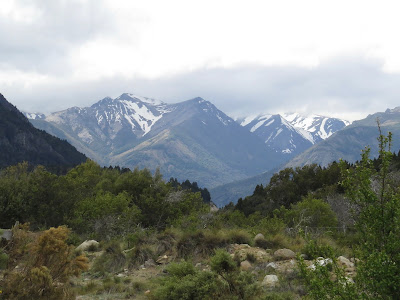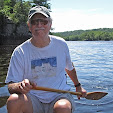If you told me a couple years ago I’d ever go trout fishing on a crystal-clear alpine lake in Patagonia, surrounded by the snow-capped Andes, I’d have said “Yeah, in my dreams.”
Well, thanks to a healthy appetite for adventure, and to my brother, Dan, for his world-class travel-planning, those dreams have come true.
THE FLIP SIDE OF FALL
From Mendoza, Dan and I caught the next of our ten flight legs on Aerolineas Argentinas: two hours south to Bariloche, a city of 100,000 situated on the south shore of glacial Lake Nahuel Huapi, in northern Pategonia.
There we rented a car for the three-and-a-half-hour drive north to our lodging near the small town (population 25,000) of San Martin de Los Andes.
Even though the roads are remarkably good, the driving proved challenging for the intermittent rain and high winds. Not to mention the constant distraction of new, neck-craning, post-card views of mountains and lakes around each bend.
Just-blooming wildflowers and the new green of the forests reminded us that we were in the southern hemisphere’s version of November—the same, climatologically, as our May back in Minnesota.
As one might expect on mountain roads, we found ourselves chained to the rear ends of a couple of slow-moving trucks and one maddening hippy-era RV/bus whose driver studiously avoided every opportunity to let us—and dozens of other cars—pass.
With a little help from Google Maps, we arrived at Rio Hermoso Lodge, a jaw-dropping property located inside Lanín National Park. The lodge, built of native wood and stone, is situated right on a bend of the quintessential mountain trout stream.
Our beautiful corner room looks out over the river and the well-manicured lawn where two of the resident horses frolicked, chasing each other back and forth.
A handsome, 16-inch rainbow trout,
caught in a crystal-clear mountain
lake in Patagonia. Could it get any
better than this?
LAGO FALKNER
The next day dawned sunny and cool. Perfect weather for our day of fishing in some of the most celebrated trout waters in the world. After an excellent buffet breakfast, we met up with Augustine, our friendly, robust guide, and hopped into his truck for the 15-minute ride to Lago Falkner.
Lago Falkner is one of this area’s illustrious Ruta de Los Siete Lagos, the Route of the Seven Lakes. (There are actually at least twice that many gorgeous lakes hereabouts.) Like the others, Falkner was scoured out, west to east, by glaciers during the late Pleistocene Epoch some 25,000 years ago. It is about 12 miles long by less than a mile wide, and runs to an incredible depth of nearly 2,000 feet.
Surrounded as it is by Cerro Falkner (8,000 feet) and several other snow-capped mountains, the lake is a catch basin for cold air, often funneling it into strong winds. So, at last, after two weeks of much warmer than expected weather at our other destinations, our layers of warm clothes would prove their worth today.
I had to be sure not to give it an inch
of slack lest it easily slide off of the
barbless hooks.
WHY IT’S CALLED FISHING, NOT CATCHING
Augustine launched his boat, and, bundled up against the crisp air, we motored down the lake for a couple of miles before he turned toward the south shore and coasted to trolling speed.
Since neither Dan nor I are very good fly-fishermen, Augustine hooked us up a couple of medium-weight spinning rigs (too clunky for this type of fishing; I’d have preferred my own ultra-light gear), with spinner lures. National park fishing regulations call for strict catch-and-release, and every hook used must be barbless.
 |
| PHOTO: Pixabay |
Determined to prove him wrong, we spent the rest of the morning drifting along that southern shore. Even in the breezy conditions Augustine skillfully maneuvered the boat, keeping the shore just beyond reach of my longest cast.
Despite a couple of halfhearted strikes, our batting average was dwindling with each cast. But watching the changing shoreline, with its rock-strewn banks, driftwood “sculptures” and occasional cascading creeks—not to mention just taking in the amazing views all around us—proved reason enough to keep at it.
 |
| PHOTO: Dan Willius |
 |
| PHOTO: Dan Willius |
Finally, after a couple hours’ work—attested to by some serious blisters erupting on our casting hands—I managed to tie into our first fish. It put up a good fight, and I had to be sure not to give it an inch of slack lest it easily slide off of the barbless hooks.
A handsome, 16-inch rainbow trout, caught in a crystal-clear mountain lake in Patagonia. Could it get any better than this? Well, I hoped, yes, if we could now just get Dan hooked up with one too.
Augustine, between boat maneuvers, had been fly fishing—with no luck. At one point, he borrowed Dan’s spinning rod and made a cast. Wouldn’t you know it, after Dan’s and my combined barrage of hundreds of casts, he’s suddenly one for one! (Isn’t a guide supposed to make you feel good about your own fishing skills?)
After such an amazing meal I would
have enjoyed a nice nap in the sun,
but we had work to do.
A SHORE LUNCH LIKE NO OTHER
At any rate, it was time for our shore lunch. Augustine found a good spot, with room to land the boat, start a fire and set up a folding table and chairs. We’d have been quite content with sandwiches, or maybe some fried trout, but no, this is Argentina; he proceeded to whip up a full-on asado for us.
 |
| PHOTO: Dan Willius |
Salami, cheese and bread to keep us occupied while he grilled; and then some lovely beef tenderloin, pork sausages and morcilla, or blood sausage. It was all complimented with a colorful and delicious beet-and-carrot salad and a bottle of nice Argentine Cabernet.
After such an amazing meal I would have enjoyed a little nap in the sun, but we had work to do. We had to get Dan at least one trout.
Working our way back along the south shore, we finally found a bit of action. Dan reeled in his own nice 16-incher, and I managed to land another, just a bit smaller.
That turned out to be the sum total of our catch for the day. But Augustine had worked very hard for us and given us a true full day of fishing. (Unlike the Mexican Pacific game fish charters I’m accustomed to, which almost always end by about 1:30, he kept us at it until 5:00.)
We headed back to the lodge, settled up with Augustine, and proceeded to the bar to celebrate our memorable day.
SAN MARTIN DE LOS ANDES
On our final day in northern Patagonia, we made the winding, 30-kilometer drive to the village of San Martin, stopping often along the way to photograph the mountains, lakes and swathes of yellow and orange wild flowers that seemed to pour off of each embankment. Once again, the weather was ideal.
San Martin, founded in 1898 by loggers and leather merchants, many of them of German descent, sits at the eastern tip of beautiful Lago Lacár. Today, it’s best known as a tourist destination, a jumping-off point for anglers, hikers and hard-core bicyclists. It is the seat of administration for Lanín National Park.
We spent a couple of hours walking around town, checking out the European Alpine-inspired architecture, some fascinating trees and plants, and people watching. We bought sandwiches and soft drinks and sat on the terraced promenade that runs along behind the municipal sand beach.
It had turned quite cool again, with a steady 20-30-mile-an-hour wind channeled down the lake’s long, narrow trough, right into our faces.
The morning of our last day, we checked out, chatted briefly with Giselle, the owner and our host, and hit the road back to Bariloche. We were tempted to stop at every scenic pull-over—many of which we’d already done—if only to more indelibly etch the beauty of this place into our souls.
We did stop a few times, but mostly the ride was quiet and reflective.
…most awesome of all, sharing this
great adventure with my smart,
thoughtful, multi-talented brother.
REFLECTION
San Martin had been the final adventure, our last destination, before the long trek back home. Misty-eyed, I recalled our arrival, just 15 days before, into the busy swirl of Buenos Aires. It seemed like a month.
Buenos Aires, with its amazing parks, the tango show and all those “good airs;” San Antonio de Areco and the unforgettable gaucho fair; our magical, music-infused dinner and those crazy painted rock formations around Salta; Mendoza’s rich, deeply-rooted wine culture; and the breathtaking alpine landscapes and crystalline waters around San Martin de los Andes.
All these indelible impressions; the kind and colorful people we met; the many chances to broaden my grasp of Spanish; the sheer variety of natural and cultural gifts we received. And perhaps most awesome of all, sharing this great adventure with my smart, thoughtful, multi-talented brother.
 |
I’ll never forget it. And if it’s true, as goes the proverb, that “we travel not to escape life, but for life not to escape us.” then I’d say we both, indeed, captured a bit of living.




















No comments:
Post a Comment